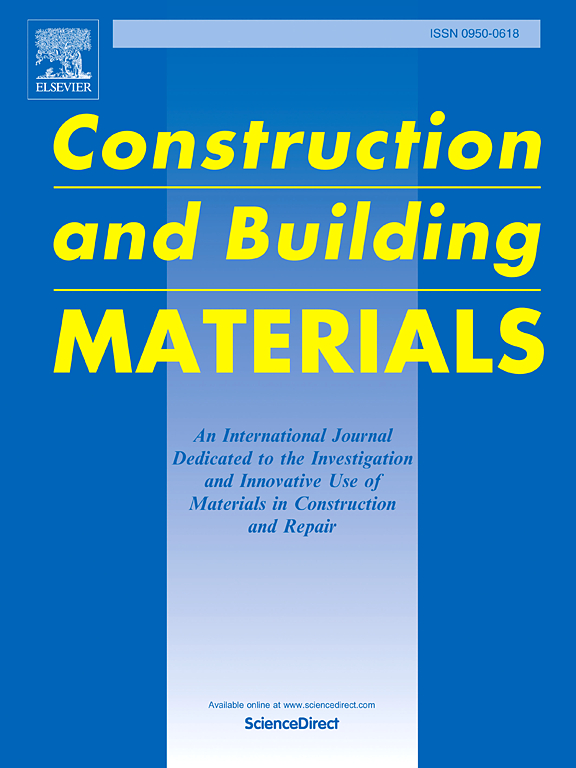杂化微胶囊对沥青粘结剂低温抗裂性能的影响
IF 7.4
1区 工程技术
Q1 CONSTRUCTION & BUILDING TECHNOLOGY
引用次数: 0
摘要
为了提高沥青粘结剂的低温抗裂性能,本研究将微胶囊与多壁碳纳米管(MWCNTs)杂交加入沥青中。通过弯曲梁流变仪(BBR)、低温动态剪切流变仪(DSR)和沥青粘结剂开裂装置(ABCD)试验,对改性沥青长期老化前后的低温蠕变性能、粘弹性性能和抗裂性能进行了综合评价。利用傅里叶变换红外光谱(FTIR)对微胶囊改性沥青老化前后的化学结构进行了分析,并计算了特征峰指数。建立了沥青低温性能指标与特征峰指标之间的Pearson相关系数。结果表明,微胶囊掺入通过提高沥青弹性变形能力、优化界面粘结、释放核心材料软化沥青、填充裂缝等方式,显著提高了沥青的低温抗裂能力。结果表明,未老化沥青的开裂温度由- 27.3℃降至- 32.1℃。当微胶囊含量超过2.5 %时,增强效果达到饱和。经过长期老化后,微胶囊芯材的释放通过增加支链烷烃含量来改变沥青组成。同时,MWCNTs可以减缓沥青中的氧化反应,减少老化引起的低温性能劣化。在未老化状态下,材料的刚度模量、残余应力百分比和开裂温度与支链烷烃的比例和芳香族化合物的相对含量密切相关。长期老化后,低温性能指标之间的相关性仍然很强,而与微观结构化学参数之间的相关性减弱。本文章由计算机程序翻译,如有差异,请以英文原文为准。
Influence of hybrid microcapsules on the low-temperature cracking resistance of asphalt binder
To improve the low-temperature crack resistance of asphalt binders, this study incorporates microcapsules hybridized with multi-walled carbon nanotubes (MWCNTs) into asphalt. The low-temperature creep properties, viscoelastic behavior, and crack resistance of the modified asphalt before and after long-term aging were comprehensively evaluated using the Bending Beam Rheometer (BBR), low-temperature Dynamic Shear Rheometer (DSR), and Asphalt Binder Cracking Device (ABCD) tests. Fourier Transform Infrared Spectroscopy (FTIR) was utilized to analyze the chemical structure of microcapsule-modified asphalt both before and after aging and to calculate the characteristic peak indices. Pearson correlation coefficients were established between the asphalt's low-temperature performance indicators and the characteristic peak indices. The results indicate that microcapsule incorporation significantly enhances the low-temperature crack resistance of asphalt by improving its elastic deformation capacity, optimizing interfacial bonding, and releasing the core material to soften the asphalt and fill cracks. As a result, the cracking temperature of unaged asphalt decreases from −27.3°C to −32.1°C. However, the enhancement effect reaches saturation when the microcapsule content exceeds 2.5 %. After long-term aging, the release of the microcapsule core material modifies the asphalt composition by increasing the branched alkane content. Meanwhile, MWCNTs can mitigate the oxidation reactions in asphalt and reduce the deterioration of low-temperature performance induced by aging. Moreover, in the unaged state, the stiffness modulus, percentage of residual stress, and cracking temperature strongly correlate with the proportion of branched alkanes and the relative content of aromatic compounds. After long-term aging, correlations among low-temperature performance indicators remain strong, whereas their correlations with microstructural chemical parameters weaken.
求助全文
通过发布文献求助,成功后即可免费获取论文全文。
去求助
来源期刊

Construction and Building Materials
工程技术-材料科学:综合
CiteScore
13.80
自引率
21.60%
发文量
3632
审稿时长
82 days
期刊介绍:
Construction and Building Materials offers an international platform for sharing innovative and original research and development in the realm of construction and building materials, along with their practical applications in new projects and repair practices. The journal publishes a diverse array of pioneering research and application papers, detailing laboratory investigations and, to a limited extent, numerical analyses or reports on full-scale projects. Multi-part papers are discouraged.
Additionally, Construction and Building Materials features comprehensive case studies and insightful review articles that contribute to new insights in the field. Our focus is on papers related to construction materials, excluding those on structural engineering, geotechnics, and unbound highway layers. Covered materials and technologies encompass cement, concrete reinforcement, bricks and mortars, additives, corrosion technology, ceramics, timber, steel, polymers, glass fibers, recycled materials, bamboo, rammed earth, non-conventional building materials, bituminous materials, and applications in railway materials.
 求助内容:
求助内容: 应助结果提醒方式:
应助结果提醒方式:


